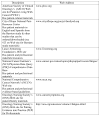Cancer-related fatigue: role of oncology nurses in translating National Comprehensive Cancer Network assessment guidelines into practice
- PMID: 18842523
- PMCID: PMC3776587
- DOI: 10.1188/08.CJON.S2.37-47
Cancer-related fatigue: role of oncology nurses in translating National Comprehensive Cancer Network assessment guidelines into practice
Abstract
This article reviews the National Comprehensive Cancer Network's (NCCN's) guidelines for cancer-related fatigue (CRF) assessment and discusses many of the common barriers that hinder the translation of the CRF guidelines into practice settings. Current assessment and measurement scales validated in patients with cancer are highlighted, and case studies reflect the vital roles that oncology nurses can play in managing patients with CRF. Oncology nurses must remember to assess the "gang of 7" (i.e., anemia, pain, sleep difficulties, nutrition issues, deconditioning or changes in activity patterns, emotional distress [depression or anxiety], and presence of comorbidities) that may affect workup, treatment, and supportive care referrals. Teaching patients about the importance of viewing CRF as the "sixth vital sign" can emphasize this symptom's importance and significance. Oncology nurses also can recognize the many patient-, provider- and system-related barriers that exist and work with others in a systematic and collaborative fashion within the system to decrease these barriers and begin to incorporate a simple intensity scale for CRF assessment and screening, documentation, and ongoing monitoring. By using available resources, oncology nurses can play significant roles in the translation of the NCCN's evidence-based practice guidelines for CRF in their practice settings.
Figures
References
-
- Aaronson NK, Ahmedzai S, Bergman B, Bullinger M, Cull A, Duez NJ, et al. The European Organization for Research and Treatment of Cancer QLQ-C30: a quality-of-life instrument for use in international clinical trials in oncology. Journal of the National Cancer Institute. 1993;85:365–376. - PubMed
-
- Ahlberg K, Ekman T, Gaston-Johansson F, Mock V. Assessment and management of cancer-related fatigue in adults. Lancet. 2003;362:640–650. - PubMed
-
- Barsevick AM. The elusive concept of the symptom cluster. Oncology Nursing Forum. 2007;34:971–980. - PubMed
-
- Basch E, Iasonos A, McDonough T, Barz A, Culkin A, Kris MG, et al. Patient versus clinician symptom reporting using the National Cancer Institute Common Terminology Criteria for Adverse Events: results of a questionnaire-based study. The Lancet Oncology. 2006;7:903–909. - PubMed
Publication types
MeSH terms
Grants and funding
LinkOut - more resources
Full Text Sources
Medical


